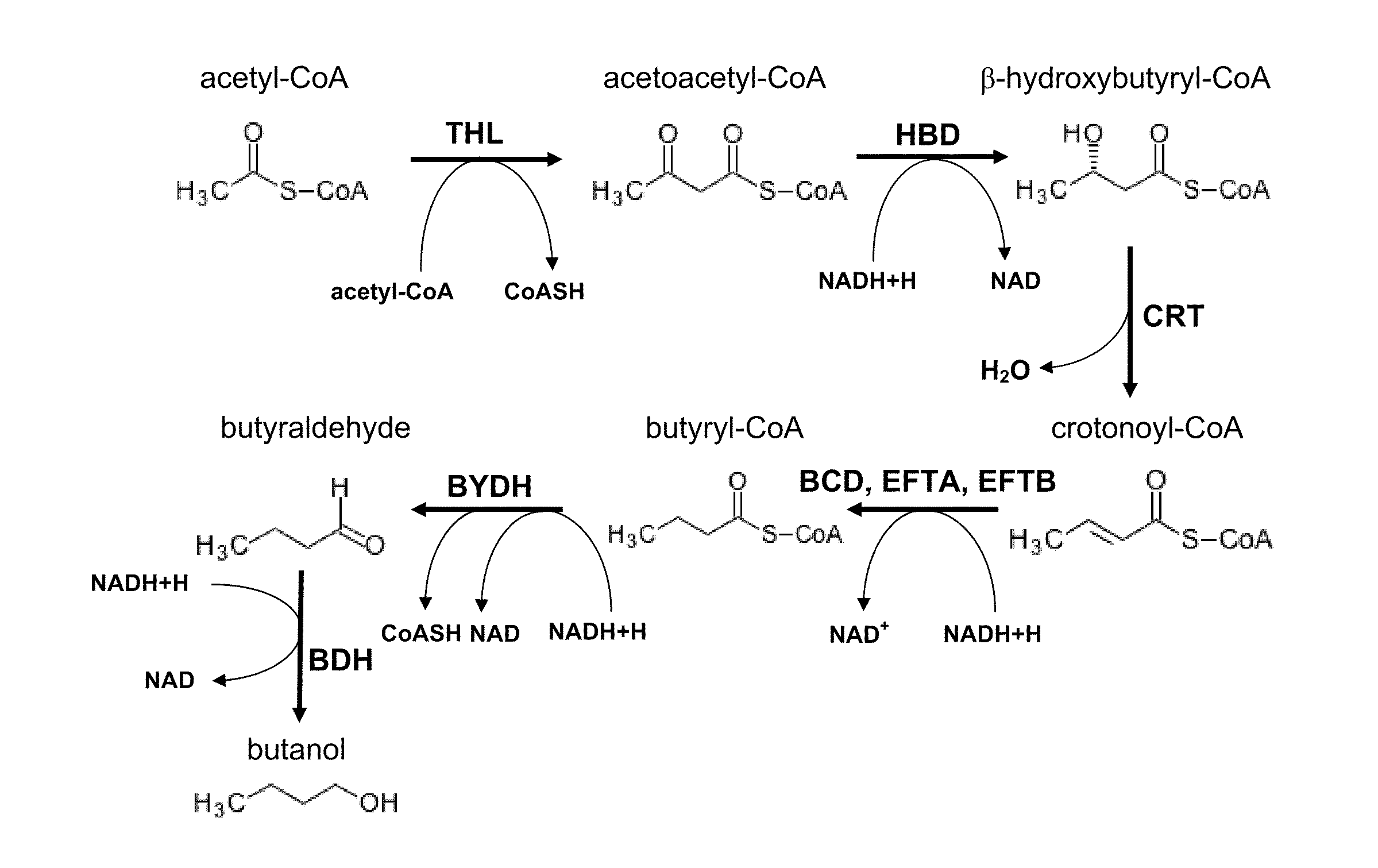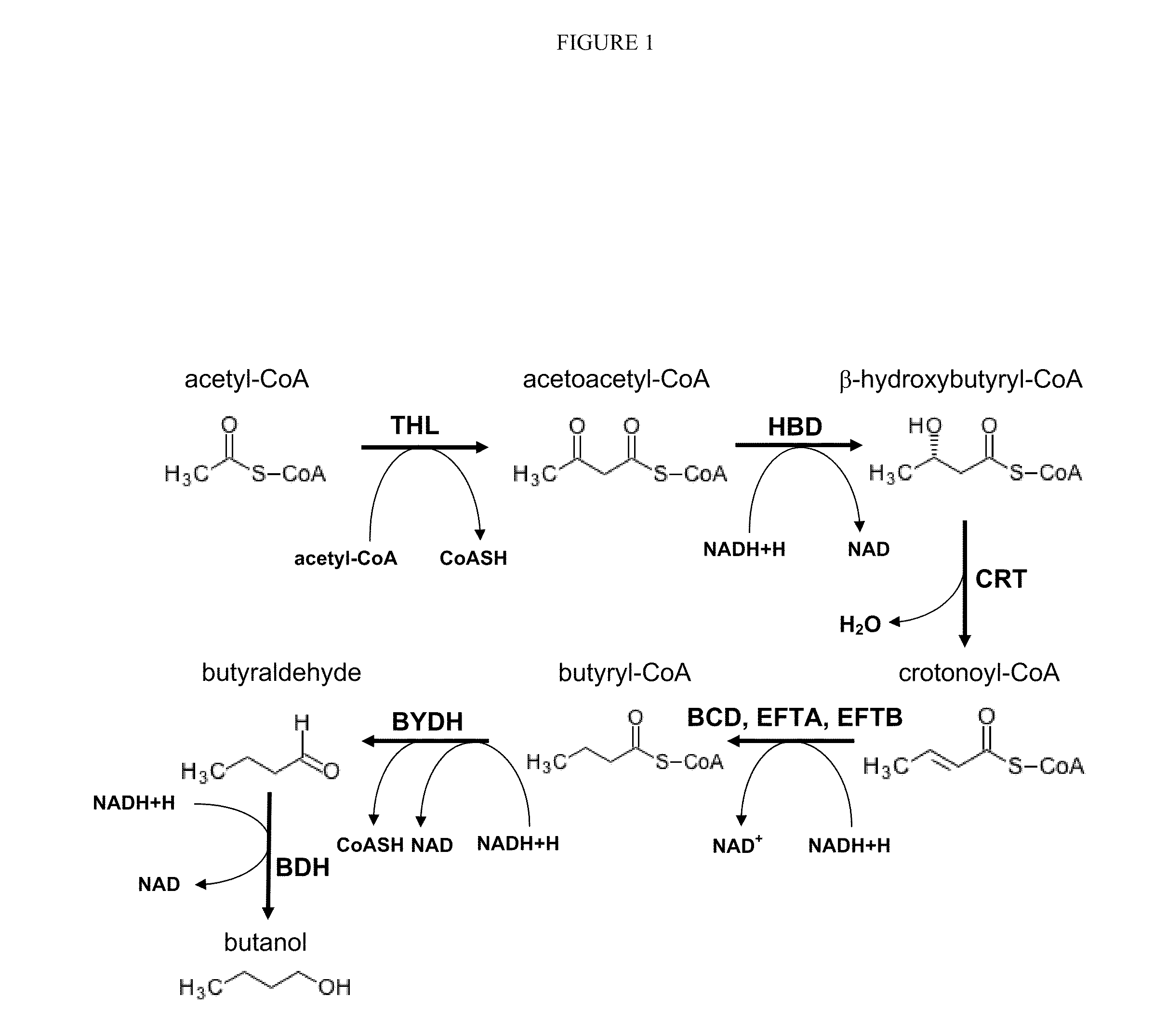Methods for the production of n-butanol
a technology of n-butanol and n-butanol, which is applied in the field of n-butanol, can solve the problems of food crops, fermentation process termination, and butanol production self-limiting,
- Summary
- Abstract
- Description
- Claims
- Application Information
AI Technical Summary
Benefits of technology
Problems solved by technology
Method used
Image
Examples
example 1
Construction of Expression Plasmids Encoding Cellulase Genes
[0111]Expression constructs encoding cellulases for co-display on the yeast cell wall surface were constructed by fusing the cellulase genes with the DNA encoding the secretion signal sequence of glucoamylase from Rhizopus oryzae. The secretion signal is responsible for delivery of the cellulase to the cell wall. The gene, encoding the C-terminal half of S. cerevisiae α-agglutinin was linked to the 3′-end of the cellulase. The α-agglutinin part of the recombinant protein allows for the attachment to the cell wall. Furthermore, all three cellulases were also expressed in secreted soluble forms that are not attached to the cell wall. Expression constructs for secreted forms lacked the α-agglutinin portion.
[0112]DNA sequences of cellulase genes are known, and the following genes were used: T. reesei endoglucanase II (GenBank accession number DQ178347); T. reesei cellobiohyrdolase II (GenBank accession number M55080) and A. acu...
example 2
Construction of Expression Plasmids Encoding Butanol Pathway Genes
[0137]To express the butanol biosynthetic pathway (FIG. 1) in yeast, the AF 104 DNA was commercially synthesized by Blue Heron Bio, with the order and the position of the C. acetobutylicum genes in the AF 104 DNA shown in Table 1 and FIG. 2. The AF 104 DNA was cloned into the PENTR223 plasmid, which confers spectinomycin resistance to bacterial cells. To facilitate subsequent cloning, several restriction sites were removed from coding sequences of the C. acetobutylicum genes via one nucleotide substitutions that did not change the amino acid sequences. Specifically, the recognition sites for the restriction endonucleases shown below were mutated in the AF104 DNA as follows: XbaI (TCT / AAGA, 1014-1019), EcoRV (GA / TTATC, 1120-1125), PstI (CT / AGCAG, 1417-1422), PstI (CT / AGCAG, 6650-6655), EcoRI (GAAT / CTC, 6966-6971), KpnI (GGT / AACC, 7999-8004), EcoRV (8761-8766), EcoRI (GA / TATTC, 9850-9855), EcoRV (GATATC / T, 12380-12385)....
example 3
Transformation of S. Cerevisiae and Transformant Selection
[0138]The derivatives of yeast strains AFY1 (MATα his3-Δ200 leu2-3,112 ura3-52 lys2-801 trp1-1) and AFY2 (MATa his3-Δ200 leu2-3,112 ura3-52 lys2-801 trp1-1) (Table 2) were used. These strains can be transformed with up to five plasmids carrying different selection markers. Transformation with the expression plasmids were performed with a lithium acetate method. Co-transformation with up to 3 plasmids was performed and the Trp+Ura+Leu+ colonies containing plasmids encoding cellulases or cellulases and butanol pathway genes were selected. To express the butanol pathway genes alone, single drop-out media were used.
[0139]The yeast transformation procedure used was a slightly modified version of the protocol described in Ausubel et al., (2002). Cells from an overnight culture were resuspended in 50 mL YPD (start OD600 of 0.2) and grown to an OD600 of 0.5-0.7. The cells were harvested by centrifugation (1,500 g, 5 min) and resuspen...
PUM
| Property | Measurement | Unit |
|---|---|---|
| pH | aaaaa | aaaaa |
| pH | aaaaa | aaaaa |
| pH | aaaaa | aaaaa |
Abstract
Description
Claims
Application Information
 Login to View More
Login to View More - R&D
- Intellectual Property
- Life Sciences
- Materials
- Tech Scout
- Unparalleled Data Quality
- Higher Quality Content
- 60% Fewer Hallucinations
Browse by: Latest US Patents, China's latest patents, Technical Efficacy Thesaurus, Application Domain, Technology Topic, Popular Technical Reports.
© 2025 PatSnap. All rights reserved.Legal|Privacy policy|Modern Slavery Act Transparency Statement|Sitemap|About US| Contact US: help@patsnap.com



